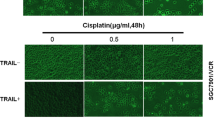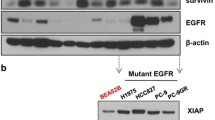Abstract
Purpose
PNAS-4, a novel pro-apoptotic gene activated during the early response to DNA damage, can inhibit proliferation via apoptosis when overexpressed in some tumor cells. The objectives of this study were to determine whether PNAS-4 could enhance apoptosis induced by cisplatin besides its induction of apoptosis, and to evaluate the usefulness of combined treatment with mouse PNAS-4 (mPNAS-4) gene therapy and low-dose cisplatin chemotherapy in the inhibition of tumor growth in colon carcinoma (CT26) and Lewis lung carcinoma (LL/2) murine models.
Methods
In this study, the in vitro growth-inhibitory and pro-apoptotic effects of PNAS-4 and/or cisplatin on CT26, LL/2, and SKOV3 cancer cells were assessed by MTT assay, flow cytometric analysis, DNA fragmentation, and morphological analysis, respectively. The in vivo antitumor activity of combined treatment with mPNAS-4 gene therapy and low-dose cisplatin were evaluated in the inhibition of tumor growth in colon carcinoma (CT26) and Lewis lung carcinoma (LL/2) murine models. Tumor volume and survival time were observed. Induction of apoptosis was also assessed in tumor tissues.
Results
In vitro, PNAS-4 inhibited proliferation of colon carcinoma (CT26), Lewis lung carcinoma (LL/2) and human ovarian cancer (SKOV3) cell lines via apoptosis, and significantly enhanced the apoptosis of CT26, LL/2, and SKOV3 cells induced by cisplatin. In vivo systemic administration of expression plasmid encoding mPNAS-4 (pcDNA3.1-mPS) and cisplatin, significantly decreased tumor growth through increased tumor cell apoptosis compared to treatment with mPNAS-4 or cisplatin alone.
Conclusions
Our data suggests that the combined treatment with mPNAS-4 plus cisplatin may augment the induction of apoptosis in tumor cells in vitro and in vivo, and that the augmented antitumor activity in vivo may result from the increased induction of apoptosis. The present study may provide a novel way to augment the antitumor efficacy of cytotoxic chemotherapy.







Similar content being viewed by others
Abbreviations
- HLE B-3:
-
Human lens epithelial cells
- pcDNA3.1-mPS:
-
pcDNA3.1 Expression plasmid encoding mouse PNAS-4 gene
- pcDNA3.1-hPS:
-
pcDNA3.1 Expression plasmid encoding human PNAS-4 gene
- TUNEL:
-
Terminal deoxynucleotidyl transferase-mediated dUTP nickend labeling
References
Reed E (1998) Platinum-DNA adduct, nucleotide excision repair and platinum based anti-cancer chemotherapy. Cancer Treatment Rev 24(5):331–344
Dhanalakshmi S, Agarwal P, Glode LM, Agarwal R (2003) Silibinin sensitizes human prostate carcinoma DU145 cells to cisplatin- and carboplatin-induced growth inhibition and apoptotic death. Int J Cancer 106(5):699–705
Niibe Y, Karasawa K, Hayakawa K (2004) Ten-year disease-free survival of a small cell lung cancer patient with brain metastasis treated with chemoradiotherapy. Anticancer Res 24(3):2097–2100
Duvillard C, Ponelle T, Chapusot C, Piard F, Romanet P, Chauffert B (2004) EDTA enhances the antitumor efficacy of intratumoral cisplatin in s.c. grafted rat colon tumours. Anticancer Drugs 15(3):295–299
Cohen SM, Lippard SJ (2001) Cisplatin: from DNA damage to cancer chemotherapy. Prog Nucleic Acid Res Mol Biol 67:93–130
Mizuho T, Hiroto I, Tomoko I, Shun H, Takao Y, Kosei Y, Kimitoshi K (2003) Activating transcription factor 4 increases the cisplatin resistance of human cancer cell lines. Cancer Res 63(24):8592–8595
Li G, Tian L, Hou JM, Ding ZY, He QM, Feng P, Wen YJ, Xiao F, Yao B, Zhang R, Peng F, Jiang Y, Luo F, Zhao X, Zhang L, Zhou Q, Wei YQ (2005) Improved therapeutic effectiveness by combining recombinant CXC chemokine ligand 10 with cisplatin in solid tumors. Clin Cancer Res 11(11):4217–4224
Folkman J (1995) Seminars in medicine of the Beth Israel Hospital, Boston: clinical applications of research on angiogenesis. N Engl J Med 333(26):1757–1763
Marshall E (1998) The road blocks to angiogenesis blockers. Science (Wash DC) 280:997–999
Santin AD, Zhan F, Bignotti E, Siegel ER, Cane S, Bellone S, Palmieri M, Anfossi S, Thomas M, Burnett A, Kay HH, Roman JJ, Obrien T, Tian E, Cannon MJ, Shaughnessy J, Pecorelli S (2005) Gene expression profiles of primary HPV16- and HPV18-infected early stage cervical cancers and normal cervical epithelium: identification of novel candidate molecular markers for cervical cancer diagnosis and therapy. Virology 331(2):269–291
Best CJ, Gillespie JW, Yi YJ, Chandramouli GV, Perlmutter MA, Gathright Y, Erickson HS, Georgevich L, Tangrea MA, Duray PH, González S, Velasco A, Linehan WM, Matusik RJ, Price DK, Figg WD, Emmert-Buck MR, Chuaqui RF (2005) Molecular alterations in primary prostate cancer after androgen ablation therapy. Clin Cancer Res 11(19):6823–6834
Filippov V, Filippova M, Duerksen-Hughes PJ (2007) The early response to DNA damage can lead to activation of alternative splicing activity resulting in CD44 splice pattern changes. Cancer Res 67(16):7621–7630
Forrest MS, Lan Q, Hubbard AE, Zhang L, Vermeulen R, Zhao X, Li G, Wu YY, Shen M, Yin S, Chanock SJ, Rothman N, Smith MT (2005) Discovery of novel biomarkers by microarray analysis of peripheral blood mononuclear cell gene expression in benzene-exposed workers. Environ Health Perspect 113(6):801–807
James ER, Fresco VM, Robertson LL (2005) Glucocorticoid-induced changes in the global gene expression of lens epithelial cells. J Ocul Pharmacol Ther 21(1):11–27
Filippov V, Filippova M, Sinha D, Duerksen-Hughes PJ (2005) PNAS-4: a novel pro-apoptotic gene activated during the early response to DNA damage. Proc Am Assoc Cancer Res 46:717
Mo DL, Zhu ZM, te Pas MFW, Li XY, Yang SL, Wang H, Wang HL, Li K (2008) Characterization, expression profiles, intracellular distribution and association analysis of porcine PNAS-4 gene with production traits. BMC Genet 9:40
Yao SH, Xie LF, Qian ML, Yang HS, Zhou L, Zhou Q, Yan F, Gou LT, Wei YQ, Zhao X, Mo XM (2008) Pnas4 is a novel regulator for convergence and extension during vertebrate gastrulation. FEBS Lett 582(15):2325–2332
Zhang P, Wang CT, Yan F, Gou L, Tong AP, Cai F, Li Q, Deng HX, Wei YQ (2008) Prokaryotic expression of a novel mouse pro-apoptosis protein PNAS-4 and application of its polyclonal antibodies. Braz J Med Biol Res 41(6):504–511
Yang F, Li ZY, Deng HX, Yang HS, Yan F, Qian ZY, Chen LJ, Wei YQ, Zhao X (2008) Efficient inhibition of ovarian cancer growth and prolonged survival by transfection with a novel pro-apoptotic gene, hPNAS-4, in a mouse model. Oncology 75(3–4):137–144
Su JM, Wei YQ, Tian L, Zhao X, Yang L, He QM, Wang Y, Lu Y, Wu Y, Liu F, Liu JY, Yang JL, Lou YY, Hu B, Niu T, Wen YJ, Xiao F, Deng HX, Li J, Kan B (2003) Active immunogene therapy of cancer with vaccine on the basis of chicken homologous matrix metalloproteinase-2. Cancer Res 63(3):600–607
Zhang R, Tian L, Chen LJ, Xiao F, Hou JM, Zhao X (2006) Combination of MIG (CXCL9) chemokine gene therapy with low-dose cisplatin improves therapeutic efficacy against murine carcinoma. Gene Ther 13(17):1263–1271
He QM, Wei YQ, Tian L, Zhao X, Su JM, Yang L, Lu Y, Kan B, Lou YY, Huang MJ, Xiao F, Liu JY, Hu B, Luo F, Jiang Y, Wen YJ, Deng HX, Li J, Niu T, Yang JL (2003) Inhibition of tumor growth with a vaccine based on xenogeneic homologous fibroblast growth factor receptor-1 in mice. J Biol Chem 278(24):21831–21836
Furihata T, Hosokawa M, Satoh T, Chiba K (2004) Synergistic role of specificity proteins and upstream stimulatory factor 1 in transactivation of the mouse carboxylesterase 2/microsomal acylcarnitine hydrolase gene promoter. Biochem J 384(Pt 1):101–110
Blezinger P, Wang J, Gondo M, Quezada A, Mehrens D, French M, Singhal A, Sullivan S, Rolland A, Ralston R, Min W (1999) Systemic inhibition of tumor growth and tumor metastases by intramuscular administration of the endostatin gene. Nat Biotechnol 17(4):343–348
Wei YQ, Zhao X, Kariya Y, Fukata H, Teshigawara K, Uchida A (1994) Induction of apoptosis by quercetin: involvement of heat shock protein. Cancer Res 54(18):4952–4957
Sanna MG, Correia JS, Ducrey O, Lee J, Nomoto K, Schrantz N, Deveraux QL, Ulevitch RJ (2002) IAP suppression of apoptosis involves distinct mechanisms: the TAK1/JNK1 signaling cascade and caspase inhibition. Mol Cell Biol 22(6):1754–1766
Wu SY, Loke HN, Rehemtulla A (2002) Ultraviolet radiation-induced apoptosis is mediated by Daxx. Neoplasia 4(6):486–492
Sauter BV, Martinet O, Zhang WJ, Mandeli J, Woo SL (2000) Adenovirus-mediated gene transfer of endostatin in vivo results in high level of transgene expression and inhibition of tumor growth and metastases. Proc Natl Acad Sci U S A 97(9):4802–4807
Wei YQ, Wang QR, Zhao X, Yang L, Tian L, Lu Y, Kang B, Lu CJ, Huang MJ, Lou YY, Xiao F, He QM, Shu JM, Xie XJ, Mao YQ, Lei S, Luo F, Zhou LQ, Liu CE, Zhou H, Jiang Y, Peng F, Yuan LP, Li Q, Wu Y, Liu JY (2000) Immunotherapy of tumors with xenogeneic endothelial cells as a vaccine. Nat Med 6(10):1160–1166
Dings RPM, Yokoyama Y, Ramakrishnan S, Griffioen AW, Mayo KH (2003) The designed angiostatic peptide anginex synergistically improves chemotherapy and antiangiogenesis therapy with angiostatin. Cancer Res 63(2):382–385
Kaplan EL, Meier P (1958) Nonparametric estimation from incomplete observations. J Am Stat Assoc 53(282):457–481
Peto R, Pelo J (1972) Asymptotically efficient rank invariant test procedures. J R Stat Soc Ser A Gene 135:185–206
Li J, Wang F, Haraldson K, Protopopov A, Duh FM, Geil L, Kuzmin I, Minna JD, Stanbridge E, Braga E, Kashuba VI, Klein G, Lerman MI, Zabarovsky ER (2004) Functional characterization of the candidate tumor suppressor gene NPRL2/G21 located in 3p21.3C. Cancer Res 64(18):6438–6443
Sfikakis PP, Souliotis VL, Katsilambros N, Markakis K, Vaiopoulos G, Tsokos GC, Panayiotidis P (1996) Downregulation of interleukin-2 and α-chain interleukin-2 receptor biosynthesis by cisplatin in human peripheral lymphocytes. Clin Immunol Immunopathol 79(1):43–49
Garzetti GG, Ciavattini A, Provinciali M, Valensise H, Romanini C, Fabris N (1994) Influence of neoadjuvant polychemotherapy on natural killer cell activity in patients with locally advanced cervical squamous carcinoma. Gynecol Oncol 52(1):39–43
Heise C, Sampson-Johannes A, Williams A, McCormick F, Von Hoff DD, Kirn DH (1997) ONYX-015, an E1B gene-attenuated adenovirus, causes tumor-specific cytolysis and antitumoral efficacy that can be augmented by standard chemotherapeutic agents. Nat Med 3(6):639–645
Alemany R, Gomez-Manzano C, Balague C, Yung WK, Curiel DT, Kyritsis AP, Fueyo J (1999) Gene therapy for gliomas: molecular targets, adenoviral vectors, and oncolytic adenoviruses. Exp Cell Res 252(1):1–12
Eastman A, Rigas JR (1999) Modulation of apoptosis signaling pathways and cell cycle regulation. Semin Oncol 26(5 Suppl 16):7–16
Fichtinger-Schepman AM, van der Veer JL, den Hartog JH, Lohman PH, Reedijk J (1985) Adducts of the antitumor drug cis-diamminedichloroplatinum(II) with DNA: formation, identification, and quantitation. Biochemistry 24(3):707–713
Vaisman A, Varchenko M, Said I, Chaney SG (1997) Cell cycle changes associated with formation of Pt-DNA adducts in human ovarian carcinoma cells with different cisplatin sensitivity. Cytometry 27(1):54–64
Faivre S, Chan D, Salinas R, Woynarowska B, Woynarowski JM (2003) DNA strand breaks and apoptosis induced by oxaliplatin in cancer cells. Biochem Pharmacol 66(2):225–237
Alexander DR (2004) Oncogenic tyrosine kinases, DNA repair and survival: the role of Bcl-xL deamidation in transformation and genotoxic therapies. Cell Cycle 3(5):584–587
Jensen R, Glazer PM (2004) Cell-interdependent cisplatin killing by Ku/DNA dependent protein kinase signaling transduced through gap junctions. Proc Natl Acad Sci USA 101(16):6134–6139
Acknowledgments
The authors thank Dr. Ning Xu for her advice, discussion, and critical review of the manuscript, and Dr. Yang Wan for their technical support. This work was supported by National Key Basic Research Program of China (2004CB518800, 2005CB522506).
Conflicts of interest statement
No potential conflicts of interest were disclosed.
Author information
Authors and Affiliations
Corresponding authors
Additional information
Z. Yuan and F. Yan contributed equally to this work.
Rights and permissions
About this article
Cite this article
Yuan, Z., Yan, F., Wang, Ys. et al. PNAS-4, a novel pro-apoptotic gene, can potentiate antineoplastic effects of cisplatin. Cancer Chemother Pharmacol 65, 13–25 (2009). https://doi.org/10.1007/s00280-009-0998-5
Received:
Accepted:
Published:
Issue Date:
DOI: https://doi.org/10.1007/s00280-009-0998-5




